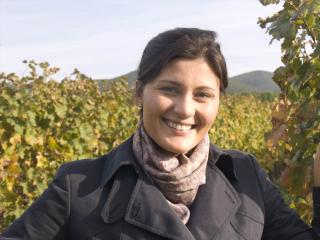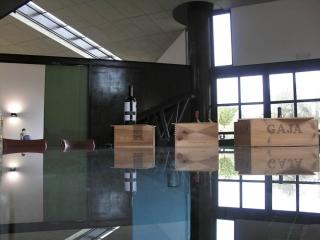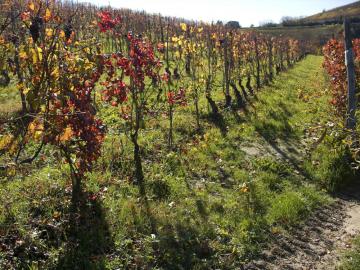Gaia Gaja is no Lady Gaga
POSTED ON 08/12/2009Gaia Gaja breezed into town yesterday to put on a tasting with her importer Armit at the Soho Hotel, celebrating the 150th year since her great, great grandfather Giovanni Gaja, founded what has become today one of Italy’s most famous wines, if not the most famous. Lady Gaja? Hardly. Gaia Gaja is unusual not just for her rather extraordinary name. Some of the world’s leading families have produced great figures that bestrode the 20th century world stage like giants, among them Miguel Torres, Piero Antinori, Robert Mondavi and one of the greatest egos of them all, Angelo Gaja. Their charisma has often made it difficult for their sons and daughters to emerge from the enveloping shadow they cast. While the children of Torres and Antinori are gradually making that transition, those of Robert Mondavi crashed and burned because they couldn’t hold a candle to the great man. Gaia Gaja, now 30, is not only highly intelligent and charming, but she’s already showing an independent way of doing things that seem to spring from the same well-spring of passion handed down by generations of Gajas.
 Gaia Gaja
Gaia Gaja
She began the tasting by explaining how difficult it is for some to pronounce the J in Gaja because J is not an Italian but a Spanish letter, so their ancestors were originally Spanish. Then straight into 2009, which, after 5 months of snow between November last year and March this, has produced ‘another great vintage in Piemonte’. When her grandfather Giovanni made wine, it was typical for there to be three good vintages a decade, two average and five mediocre. ‘Piemonte has never been so blessed’, with 1988 – 1990 the first run of three successive great vintages. If it was hard for her grandfather to reach 12.5% alcohol, the opposite is the case today, she told us. Not only has the climate changed since 1945, adding one to one and a half degrees of alcohol to the wines and given a helping hand to late-ripening varieties, but techniques have greatly improved since the struggle between traditionalists and modernists in the 1970s and 1908s, brought benefits to both sides.
The first wine on the agenda was the only white, the 1997 Gaia & Rey Chardonnay. It was Piemonte’s first chardonnay, Gaia, told us, made in 1983 when ‘people in Piemonte didn't even consider white wine as a wine’. It was the first Italian white aged in barrique and made from a vineyard of 2.5 hectares, which was added to later when Angelo Gaja bought another property in Serralunga, planting four hectares with mixed clones from a French nursery.
It was followed by a Bordeaux blend, the 2006 Camarcanda, Gaja, from Gaja’s venture in Bolgheri. ‘It’s a region we consider the New World of Italy, because it’s new for Italy and planted with French rather than Italian varieties. Her father ‘chose the opposite of Piemonte as he wanted to do something that wasn't what his father and grandfather did’. The result is an 80 hectare property producing three different wines with Carmarcanda, whose first vintage was in 2000, the top of the range. The vineyard is at sea level, protected from saline breezes by coastal plantings of pine, with a diversity of soils, but Camarcanda comes only from the white soils with clay and gravel that bring structure.
 Camarcanda
Camarcanda
Still in Tuscany, we tasted two Brunello di Montalcino reds from Gaja’s estate, Pieve Di Santa Restituta, the 2004 Brunello di Montalcino Rennina and the 2001 Brunello di Montalcino Sugarille. The winery is directly south of Montalcino in an area producing wines of great structure. As Gaia explained, Montalcino has grown rapidly over the past 40 years. Until the 1960s, she said, there were was 60 hectares of Montalcino producing 150,000 bottles. Today Brunello is 2000 hectares farmed by 250 producers and a production of 7 million bottles. The 16 hectare property was originally run by the clergy, and bought by her father in 1994 from its most recent owner, Roberto Bellini, who was keen to avoid selling to a Brunello producer. Sugarille is the single vineyard, Rennina a blend. The perfectionist Gaja declassified the 2002 and 2003 vintages as not good enough and made the 2004, fermenting in stainless steel, keeping the wine in 500 litre casks for two years before transferring them to concrete.
Back to Piemonte and the winery founded in 1859 by Giovanni Gaja (1832 - 1914) who started with two hectares and sold the wine in his tavern, The Steamboat. As Gaia explained, there wasn’t in fact a steamboat but rather a craft that was pulled across the river by pulley. At the time, farmers only grew the grapes and sold to negociants. Giovanni decided to close the tavern and concentrate on growing grapes. He had eight sons and left a piece of vineyard to each of his sons, but it seems that four were heavy drinkers, three were gamblers, and then there was Angelo Gaja (1876 - 1944), her great grandfather, whose marriage to a tough woman, Clotilde Rey (1880 – 1961) kept him on the straight and narrow. Fast forward to 1964 and his son, Giovanni Gaja, who introduced water to Barbaresco. He was a visionary and proud, and the first to really understand the quality of Barbaresco which at that time was considered inferior to Barolo.
 Angelo's Lair
Angelo's Lair
When Giovanni Gaja bought Sori San Lorenzo (called Secondina) in the 1950s, the land was planted with grain. The basic soil is clay and limestone, as Langhe was at the bottom of the sea millions of years ago. The difference between San Lorenzo, Sori Tildin and Costa Russi lies is in the exposure, hence Angelo Gaja found the word Sori, meaning top of the hill facing south. Piemonte had always had its historic crus but the single vineyard concept was quite new. The first single vineyard Barbaresco was created in 1967. ‘Now everyone has a single vineyard Barbaresco that’s generally their top wine, but for us the top is the ‘democratic’ Barbaresco’. Traditionally, plantings were horizontal for steepness and against erosion, but from the 1970s, Angelo Gaja started to plant vertically for better exposure and higher plant density, using the 161/49 graft for lower vigour. Costa Russi is an old vineyard though and remained untouched.
With lunch we had the 2006 Barbaresco, Gaja and the 2004 Camarcanda, Gaja. The 2006 Barbaresco is lovely, still incredibly youthful but a wine with a seductively approachable quality of dark cherry fruit, still firmly encased in tannins, but fine tannins, with a touch of incense spice and that deliciously perky acidity that marks the best Barbaresco out for elegance. The 2004 Camarcanda was also excellent, deep, rich, cassis-fruity with a stylish oak spice veneer, and a little riper and more opulent than the 2006. Excellent. And off she breezed again. When I say breezed, I mean breezed. Gaia had arrived from Milan in the morning for the tasting, and was headed straight back to Armani country in time for some serious shopping on the Day of the Immaculate Conception.
 Autumn in Piemonte
Autumn in Piemonte
The Wines
1997 Gaia & Rey Chardonnay
Named after Gaia and Angelo’s grandmother, this is yellow gold, rich and honeyed on the nose, with an underlying nuttiness; still fresh, lovely rich fruit, powerful concentration of fruit, very nicely integrated oak that gives the wine a nice toasted nuttiness, which combines well with its honeyed rich fruit, power, a hint of truffle, and fresh lemony acidity. 90
2006 Camarcanda, Gaja
A blend of 50% merlot, 40% cabernet sauvignon and 10% cabernet franc, this has a vivid rich colour and fragrant fresh aromatic quality, a stylish touch of oak, with a hint of herb and sweet pipe tobacco, still evidently youthful; vibrant fruit quality, seamless, sleek intense cassis flavour with a green capsicum edge, supple yet distinct tannins, and a fine fresh elegant, cleansing blade of acidity giving overall fine balance and suggesting a 7 – 10 year ageing period. 92
2004 Brunello di Montalcino Rennina, Pieve Di Santa Restituta, Gaja.
Good youthful colour, excellent sangio nose, classic aromas of sangio, a Worcester sauce savoury element, spice and cherry, tinged by polished oak spice, lovely seductive dark berry and sour cherry fruit, very seductively seamless textured, with a real finesse of textured tannins and juicy freshness, all in all very finely balanced and sleek with a deceptive structure. 94
2001 Brunello di Montalcino Sugarille, Pieve Di Santa Restituta, Gaja
Still relatively youthful in colour, fine, evolved nose of vanilla oak, powerfully concentrated fruit in red berry fruits spectrum tinged with new oak vanilla, and the tannins are still very firm, the acidity also firm and savoury. This is a more angular and slightly rustic red, more traditional in style than the 2004, almost chewy, chunky and dry on the finish and still needing time to soften down. 91
2005 Sori Tildin, Gaja
Ruby garnet in colour, seductive nebbiolo nose, intense, fresh, youthful floral and dark cherry fruit quality lightly tinged with oak and tobacco spice; rich and vibrant, intense red fruits, concentrated and rich, yet elegant and full-flavoured, a subtle framework of very fine tannins for nebbiolo, fresh acidity, fine balance, fine savoury dry, firm finish; a wine with fruit and structure, still youthful and needing 10 years plus. 94
2001 Conteisa, Gaja
Youthful ruby garnet in colour, fine nose, floral, aromatic dark cherry and red berry nebbiolo, hint of malt whisky, lovely sweet vibrant youthful dark berry fruits quality, intensely flavoured, rich and cherryish with the tannins just starting to soften the structure yielding into suppleness while the acidity keep the wine fresh and invigorating. Lovely now, but will go on for 10 years. 93
1998 Costa Russi, Gaja
Garnet ruby in colour, still very youthful, superb nose with mulberry-like red berry fruits and hints of vanilla and smoky wood spice, truffle and leather; gorgeously rich spicy fruit quality, fine succulent tannins, melts in the mouth like dark chocolate; and has that bittersweet savoury quality too, overall beautifully balanced and while ready for drinking, only just, this will surely last another 10 years plus. 96+
1996 Sori San Lorenzo, Gaja
Excellent deep youthful ruby colour, shading to garnet at the rim, wonderfully evolved aromas of dark fruits, truffley earth and leathery undertones; deliciously sweet concentrated mulberry and dark berry fruit richness, softened down fine-grained tannins holding this together in an elegant framework of supple texture and elegant expressively fresh acidity, finishing a tad austere, quite chunky and dry. 93
1990 Sperss, Gaja
From Gaja’s property in Serralunga, (first vintage was the 1988) with compact clay soils, and at relatively high altitude, it’s cool, creating wines of structure and ageing potential.
Good vivid youthful colour, savoury with meaty undertones with notes of mushroom, initially sweet and floral on the palate, while the leather and meaty tones and firm dry tannins soon kick in, but there's a supple quality of fruit, fine, fresh, savoury acidity and excellent overall balance. 93
1971 Barbaresco, Gaja
This included Costa Russi. 1971 was a small vintage, the grapes were very concentrated in sugar. Copper treatment against mildew burned some of the berries, so acted as a form of green harvest. Amazingly youthful colour still, deep red shading to garnet, tealeaf, malt, leather, savoury notes of evolution; lovely sweet and sour supple fruit, beautifully evolved richness and concentration of fruit that's almost beyond primary fruit now and gone to something complex: sweetly stony, leathery and evolved, while retaining its fine fresh natural acidity. 92
1961 Barbaresco, Gaja
This wine included all Gaja’s vineyards and came from an outstanding vintage in Piemonte. Garnet in colour, dry malty, demerara sugar, leathery and starting to show the antimacassar undertones of age and oxidation; still sweet on the palate, very soft and juicy almost, with old leathery tones. Needs to be drunk, if there's any left, because it's starting to show its age, but the sweetness of a touch of residual sugar is holding it up well. 89
 Autumnal nebbiolo vineyards
Autumnal nebbiolo vineyards

